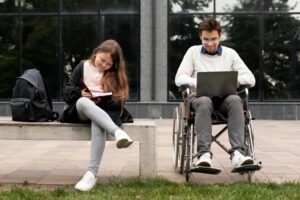Support for inclusive pedagogical approaches to teaching with digital technologies
Materials
1. Introduction
The integration of digital technologies into higher education has revolutionized teaching and learning, offering new avenues for enhancing student engagement and access to information. However, this digital transformation also poses challenges in ensuring that all students benefit equitably, highlighting the need for inclusive pedagogical approaches (Florian & Beaton, 2018). Inclusive pedagogy recognizes the diverse needs of students and seeks to provide equitable learning opportunities by accommodating different learning styles, cultural backgrounds, and abilities (Hockings, 2010). Research indicates that without deliberate inclusive strategies, digital technologies can inadvertently widen the gap between students, particularly affecting those with disabilities or limited access to technology (Seale, 2013; Alper & Goggin, 2017). Therefore, higher education institutions must adopt comprehensive measures at the leadership and management levels to support and implement inclusive pedagogical approaches through digital technologies, fostering a supportive and equitable learning environment.
2. How Schools Can Support and Implement Inclusive Pedagogical Approaches through Digital Technologies
Implementing inclusive pedagogy through digital technologies requires a multifaceted approach involving strategic planning, policy development, resource allocation, and cultural change. The following strategies outline how higher education institutions can achieve this, supported by existing research and real-world examples.
2.1 Vision and Strategic Planning
Establishing a clear vision and strategic plan for inclusivity is fundamental for aligning institutional efforts. Leadership must integrate inclusive digital pedagogy into the institution’s mission and long-term goals, ensuring that inclusivity becomes a core value rather than a peripheral concern (Kezar & Holcombe, 2017).
Florian and Beaton (2018) emphasize that a strong vision for inclusivity guides policy development and resource allocation. For example, the University of Edinburgh’s strategic plan explicitly includes accessibility and inclusion as key objectives, directing institutional initiatives and investments towards these goals (University of Edinburgh, 2019). Similarly, the University of Worcester developed an Inclusive Curriculum Framework as part of its strategic planning, embedding inclusivity into teaching and learning practices (Morgan & Houghton, 2011).
By articulating a commitment to inclusivity at the highest level, institutions signal the importance of this priority to all stakeholders, fostering a unified approach to implementing inclusive pedagogical practices.
2.2 Policy Development and Implementation
Creating and enforcing policies that mandate inclusive practices ensures consistency and accountability across the institution. Policies should address accessibility standards, curriculum diversity, and legal compliance with regulations such as the Americans with Disabilities Act (ADA) and the Equality Act 2010 in the UK (Seale, 2013).
Scott, McGuire, and Shaw (2003) argue that policy development is crucial for institutionalizing inclusive practices, providing a framework for implementation and evaluation. The California State University’s Accessible Technology Initiative (ATI) exemplifies this approach by requiring all digital content and platforms to comply with accessibility guidelines, thus ensuring that students with disabilities can access educational materials (CSU, 2019). The University of Melbourne has also implemented policies mandating that all course materials meet accessibility standards, providing support for faculty to adapt their content accordingly (University of Melbourne, 2017).
By establishing clear policies, institutions set expectations for faculty and staff, promoting a consistent application of inclusive practices across all departments.
2.3 Resource Allocation
Allocating sufficient resources is essential for supporting inclusive pedagogical approaches. Institutions need to invest in accessible technologies, provide financial support for students who need it, and fund professional development for faculty (Gordon, Meyer, & Rose, 2015).
Burgstahler (2015) highlights that investment in accessibility yields positive outcomes for student engagement and success. The Open University in the UK has invested heavily in accessible online platforms and materials, enabling students with disabilities and those from diverse backgrounds to engage fully with their courses (Greller, Ebner, & Schön, 2014). The University of Central Florida provides funding for accessibility tools and services, ensuring that technological resources are available to support inclusive learning environments (UCF, 2020).
Resource allocation demonstrates institutional commitment and enables the practical implementation of inclusive strategies, making it possible for all students to participate fully in the educational experience.
2.4 Professional Development and Faculty Support
Faculty are pivotal in implementing inclusive pedagogical approaches, and providing professional development opportunities enhances their ability to utilize digital technologies inclusively (Lombardi, Murray, & Gerdes, 2011). Training programs should focus on Universal Design for Learning (UDL), accessibility, and culturally responsive teaching.
Black, Weinberg, and Brodwin (2015) emphasize that faculty development in inclusive practices leads to increased awareness and implementation of strategies that support diverse learners. The University of Washington’s DO-IT Center offers comprehensive training for faculty on inclusive teaching practices and the use of assistive technologies, resulting in improved instructional methods that benefit all students (Burgstahler, 2015). Similarly, the University of Toronto’s Accessibility Community of Practice facilitates collaboration among faculty and staff, sharing best practices and addressing challenges related to accessibility in digital learning environments (University of Toronto, 2020).
By investing in faculty development, institutions empower educators to create inclusive learning environments that accommodate all students.
2.5 Cultural Transformation
Cultivating an institutional culture that values inclusivity is essential for the sustained adoption of inclusive pedagogical approaches. Leadership can promote this culture through communication, recognition programs, and by modeling inclusive behaviors (Schein, 2010).
Tansey et al. (2018) highlight that cultural transformation requires ongoing efforts and engagement from all levels of the institution. The University of the Arts London actively promotes inclusivity through internal communications, workshops, and events, fostering a community that embraces diversity (UAL, 2018). Monash University recognizes and rewards departments and individuals who demonstrate excellence in inclusive practices, encouraging others to adopt similar approaches (Monash University, 2019).
Creating a culture of inclusivity ensures that inclusive practices are valued and integrated into everyday activities, rather than being seen as additional tasks.
2.6 Monitoring, Evaluation, and Accountability
Establishing mechanisms for monitoring and evaluating inclusivity initiatives ensures progress towards institutional goals. Setting measurable objectives, collecting data, and holding individuals accountable are key components (Tansey et al., 2018).
Fullan and Langworthy (2014) argue that accountability measures reinforce the importance of inclusivity and encourage continuous improvement. University College London publishes annual reports on their equality, diversity, and inclusion initiatives, tracking progress against set targets and identifying areas for improvement (UCL, 2020). The Georgia Institute of Technology incorporates inclusivity efforts into faculty performance evaluations, incentivizing faculty to prioritize inclusive practices in their teaching (Georgia Tech, 2017).
By monitoring and evaluating initiatives, institutions can identify successful strategies and areas needing attention, ensuring that efforts are effective, and resources are well-spent.
2.7 Stakeholder Engagement and Collaboration
Engaging stakeholders, including students, faculty, and staff, in decision-making processes ensures that inclusivity initiatives meet the actual needs of the community (Freeman, 2010). Collaboration across departments enhances resource utilization and promotes shared ownership of initiatives.
Kezar and Holcombe (2017) indicate that stakeholder engagement leads to more sustainable and impactful institutional change. The University of Michigan formed advisory committees comprising diverse stakeholders to guide their diversity, equity, and inclusion efforts, resulting in programs that are responsive and effective (University of Michigan, 2016). Arizona State University promotes interdepartmental collaboration on accessibility projects, leveraging expertise from various units to enhance inclusivity (ASU, 2018).
By involving stakeholders, institutions can develop more comprehensive and effective strategies that reflect the needs and perspectives of their community.
2.8 Curriculum and Pedagogical Innovation
Supporting curriculum redesign and innovative teaching methods is crucial for inclusivity. Embracing flexible learning models, diverse assessment methods, and incorporating multiple perspectives in content accommodate different learning styles and backgrounds (Florian & Black-Hawkins, 2011).
Florian and Beaton (2018) argue that pedagogical innovation is essential for meeting the needs of diverse learners in a digital age. Montgomery College implemented UDL principles across its courses, utilizing digital tools to provide content in various formats and offering multiple means of assessment, which improved student engagement and success (Scott, Temple, & Marshall, 2015). Harvard University’s Graduate School of Education offers grants and support for faculty to redesign courses with an emphasis on inclusivity and digital innovation (Harvard GSE, 2019).
By fostering pedagogical innovation, institutions can enhance learning experiences and outcomes for all students.
2.9 Investment in Accessible Technology Infrastructure
Ensuring that digital platforms and tools are accessible is fundamental for inclusive education. Institutions should adopt technologies that support UDL principles and provide assistive technologies to students who need them (CAST, 2018).
Gordon, Meyer, and Rose (2015) emphasize that investing in accessible technology infrastructure is a critical component of inclusive education. Oregon State University’s Ecampus provides accessible online courses and offers assistive technologies such as screen readers and captioned videos, enhancing access for students with disabilities (Ecampus, 2018). The University of Manchester supplies assistive software like text-to-speech and mind-mapping tools to support students with learning difficulties (University of Manchester, 2017).
Investment in accessible technologies ensures that digital learning environments are usable by all students, removing barriers to participation.
2.10 External Partnerships and Advocacy
Collaborating with external organizations, technology companies, and advocacy groups enhances institutional capacity to implement inclusive practices (Wenger-Trayner & Wenger-Trayner, 2015). Partnerships can provide access to resources, expertise, and innovative solutions.
Fullan and Langworthy (2014) note that external partnerships can accelerate institutional change and bring in new perspectives. The University of Southern California partnered with Microsoft to integrate accessible technologies, such as Learning Tools and Immersive Reader, into their classrooms, benefiting students with diverse needs (USC, 2017). New York University collaborates with advocacy groups like the National Center for Accessible Media to promote accessibility in education and develop best practices (NYU, 2018).
Through external partnerships, institutions can enhance their inclusivity initiatives and stay abreast of emerging technologies and methodologies.
2.11 Risk Management and Ethical Considerations
Addressing data privacy and ethical considerations is crucial when implementing digital technologies. Institutions must ensure compliance with data protection laws and ethical standards to protect student information (Solove, 2013).
Solove (2013) underscores the importance of ethical data practices in maintaining trust and compliance in educational settings. The Massachusetts Institute of Technology implements strict data protection policies and conducts regular risk assessments to safeguard student data in their digital platforms (MIT, 2019). Stanford University emphasizes ethical considerations in data usage within its inclusivity initiatives, ensuring transparency and student consent (Stanford University, 2020).
By prioritizing ethical considerations, institutions protect students and maintain the integrity of their inclusivity efforts.
2.12 Continuous Improvement and Innovation
Staying beside of emerging technologies and pedagogical approaches is essential for continuous improvement. Institutions should support research, pilot programs, and encourage innovation to enhance inclusivity (Fullan & Langworthy, 2014).
Fullan and Langworthy (2014) argue that fostering a culture of innovation contributes to the institution’s ability to adapt and improve over time. The University of British Columbia conducts research on inclusive digital pedagogy and implements pilot projects to test new technologies and teaching methods before wider adoption (UBC, 2016). Deakin University in Australia regularly tests new inclusive technologies, such as adaptive learning platforms, to ensure they meet student needs effectively (Deakin University, 2017).
By embracing innovation, institutions can continuously enhance their inclusivity strategies and respond to evolving student needs.
3. Conclusion
Implementing inclusive pedagogical approaches through digital technologies is a complex but essential endeavour for higher education institutions. By adopting the twelve strategies outlined—ranging from strategic planning and policy development to continuous innovation—schools can create a supportive culture that values diversity and ensures equitable access to education. The integration of inclusive practices requires commitment from leadership and collaboration across all levels of the institution. Real-world examples demonstrate the practical application and benefits of these strategies, leading to enhanced learning experiences and improved outcomes for all students. As digital technologies continue to evolve, institutions must remain proactive in their efforts to foster inclusivity, ensuring that all students can thrive in the digital age.
4. References
Alper, M., & Goggin, G. (2017). Digital technology and rights of people with disabilities. Disability and the Global South, 4(1), 891–907.
Arizona State University (ASU). (2018). Accessibility and Inclusive Learning Services. Retrieved from https://asu.edu/accessibility
Black, R. D., Weinberg, L. A., & Brodwin, M. G. (2015). Universal Design for Learning and Instruction: Perspectives of Students with Disabilities in Higher Education. Exceptionality Education International, 25(2), 1–16.
Burgstahler, S. (2015). Universal Design in Higher Education: From Principles to Practice (2nd ed.). Harvard Education Press.
CAST. (2018). Universal Design for Learning Guidelines version 2.2. CAST. Retrieved from http://udlguidelines.cast.org
California State University (CSU). (2019). Accessible Technology Initiative. Retrieved from https://www.calstate.edu/ati
Deakin University. (2017). Inclusive Education. Retrieved from https://www.deakin.edu.au/about-deakin/values/inclusion
Ecampus. (2018). Faculty Support and Training. Oregon State University. Retrieved from https://ecampus.oregonstate.edu/faculty/
Florian, L., & Beaton, M. (2018). Inclusive pedagogy in action: Getting it right for every child. International Journal of Inclusive Education, 22(8), 870–884.
Florian, L., & Black-Hawkins, K. (2011). Exploring inclusive pedagogy. British Educational Research Journal, 37(5), 813–828.
Freeman, R. E. (2010). Strategic Management: A Stakeholder Approach. Cambridge University Press.
Fullan, M., & Langworthy, M. (2014). A Rich Seam: How New Pedagogies Find Deep Learning. Pearson.
Georgia Institute of Technology (Georgia Tech). (2017). Accessibility and Inclusion. Retrieved from https://www.gatech.edu/accessibility
Gordon, D. T., Meyer, A., & Rose, D. H. (2015). Universal Design for Learning: Theory and Practice. CAST Professional Publishing.
Greller, W., Ebner, M., & Schön, S. (2014). Mobile learning with e-books: Effective support for dyslexic learners. In European Distance and E-Learning Network Conference Proceedings.
Harvard Graduate School of Education (Harvard GSE). (2019). Inclusive Teaching and Learning. Retrieved from https://www.gse.harvard.edu/teaching/inclusive
Hockings, C. (2010). Inclusive learning and teaching in higher education: A synthesis of research. Higher Education Academy. Retrieved from https://www.advance-he.ac.uk/
Kezar, A., & Holcombe, E. (2017). Shared Leadership in Higher Education: Important Lessons from Research and Practice. American Council on Education.
Lombardi, A. R., Murray, C., & Gerdes, H. (2011). College faculty and inclusive instruction: Self-reported attitudes and actions pertaining to universal design. Journal of Diversity in Higher Education, 4(4), 250–261.
Massachusetts Institute of Technology (MIT). (2019). Privacy and Accessibility. Retrieved from https://web.mit.edu/accessibility/
Monash University. (2019). Inclusive Teaching. Retrieved from https://www.monash.edu/learning-teaching/inclusive-teaching
Morgan, H., & Houghton, A.-M. (2011). Inclusive Curriculum Design in Higher Education: Considerations for Effective Practice across and within Subject Areas. The Higher Education Academy.
New York University (NYU). (2018). Accessibility and Accommodations. Retrieved from https://www.nyu.edu/life/student-life/student-diversity/accessible-nyu.html
Seale, J. (2013). E-learning and Disability in Higher Education: Accessibility Research and Practice. Routledge.
Scott, S. S., McGuire, J. M., & Shaw, S. F. (2003). Universal design for instruction: A new paradigm for adult instruction in postsecondary education. Remedial and Special Education, 24(6), 369–379.
Scott, S. S., Temple, P., & Marshall, D. (2015). Use of universal design for learning principles in course syllabi. Journal of Postsecondary Education and Disability, 28(2), 237–244.
Schein, E. H. (2010). Organizational Culture and Leadership (4th ed.). John Wiley & Sons.
Solove, D. J. (2013). Privacy, Big Data, and the Future of Privacy. Georgetown Law Journal, 101(3), 747–770.
Stanford University. (2020). Privacy and Data Governance. Retrieved from https://privacy.stanford.edu/
Tansey, E. A., Gallo, M. A., McGrath, J. L., Wytock, D. H., & Prestwich, G. D. (2018). Strategies for building a positive learning environment in higher education. Advances in Physiology Education, 42(1), 36–41.
University College London (UCL). (2020). Equality, Diversity, and Inclusion Strategy. Retrieved from https://www.ucl.ac.uk/equality-diversity-inclusion/
University of British Columbia (UBC). (2016). Equity and Inclusion in Teaching and Learning. Retrieved from https://equity.ubc.ca/
University of Edinburgh. (2019). Strategic Plan 2016. Retrieved from https://www.ed.ac.uk/about/strategy-planning/strategic-plan-2016
University of Manchester. (2017). Assistive Technology Services. Retrieved from https://www.itservices.manchester.ac.uk/ats/
University of Melbourne. (2017). Accessibility and Inclusivity Policy. Retrieved from https://policy.unimelb.edu.au/
University of Michigan. (2016). Diversity, Equity & Inclusion Strategic Plan. Retrieved from https://diversity.umich.edu/
University of Southern California (USC). (2017). Accessibility at USC. Retrieved from https://accessibility.usc.edu/
University of Toronto. (2020). Accessibility Community of Practice. Retrieved from https://hrandequity.utoronto.ca/accessibility/
Wenger-Trayner, E., & Wenger-Trayner, B. (2015). Communities of Practice: A Brief Introduction. Retrieved from https://wenger-trayner.com/introduction-to-communities-of-practice/
1. Leadership/ School’s perspective
Financial support for inclusive digital education
10 min
Understand the importance of Financial Support for Inclusive Digital Education. Understand the role of financial support. Explain Financial Support for Inclusive Digital Education.
Financial Support, Inclusive, Digital Education








Funded by the European Union. Views and opinions expressed are however those of the author(s) only and do not necessarily reflect those of the European Union or the European Education and Culture Executive Agency (EACEA). Neither the European Union nor EACEA can be held responsible for them (2022- 1 -SI01 -KA220-HED-000088368).






